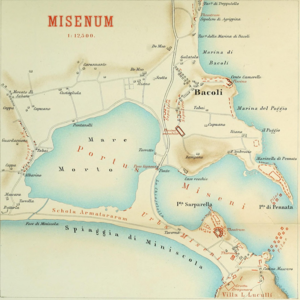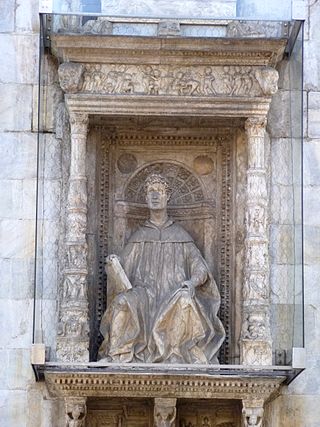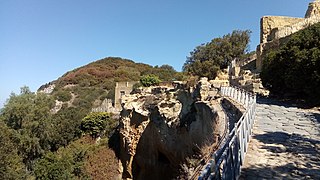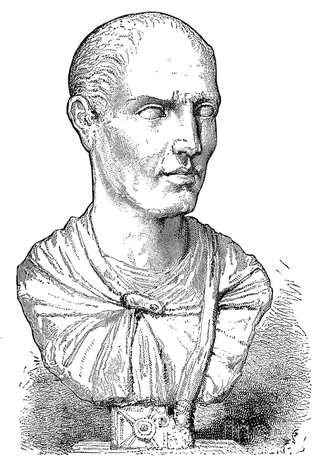This article needs additional citations for verification .(January 2020) |
Miseno is one of the frazioni of the municipality of Bacoli in the Italian Province of Naples. Known in ancient Roman times as Misenum, it is the site of a great Roman port.
This article needs additional citations for verification .(January 2020) |
Miseno is one of the frazioni of the municipality of Bacoli in the Italian Province of Naples. Known in ancient Roman times as Misenum, it is the site of a great Roman port.


Nearby Cape Miseno marks the northwestern end of the Bay of Naples.
According to mythology, Misenum was named after Misenus, a companion of Hector and trumpeter to Aeneas. Misenus is supposed to have drowned near here after a trumpet competition with the sea-god Triton, as recounted in Virgil's Aeneid.
With its gorgeous natural setting and the nearby important Roman cities of Puteoli and Neapolis, Misenum became, from the Republican era, the site of Roman luxury villas, such as that of Marius which was taken by Sulla and later bought by Lucullus. It was then appropriated as imperial property and Tiberius died there in 37 AD. [1]
In 39 BC, Misenum was the site where the short-lived Pact of Misenum was made between Octavian (later Augustus), and his rival Sextus Pompeius. [2]
The first naval base, Portus Julius , nearby at Puteoli, was built during the civil wars in 36 BC by Marcus Agrippa, the right-hand man of the emperor Augustus. It was abandoned and a new base at Misenum developed into the largest Roman port for the Classis Misenensis , the most important fleet. It was a double harbour with two natural basins that exist today. The outer harbour was protected by two breakwaters marked from the south by a double row of pilae in the sea running toward the projection opposite Punta Pennata and from the north by three pilae running south from the Punta Pennata. The inner harbour, the Mare Morto, to the west lies behind a spit of land, and may have been for the reserve fleet and for repair. A channel was cut through the spit to link the harbours.
The town became a municipium in the 1st century.
Pliny the Elder was the praefect in charge of the naval fleet at Misenum in AD 79, at the time of the eruption of Mount Vesuvius, visible to the south across the Bay of Naples. Seeing the beginnings of the eruption, Pliny left for a closer view and to effect a possible rescue, and was killed during the eruptions. The account of his death is given by his nephew Pliny the Younger, who was also resident in Misenum at the time.


The ancient town including the naval barracks lies below the modern one and hence its layout is poorly understood. Most research has therefore been on the nearby coastal villas which included the fishponds, private harbours and docks in opus caementicium . [3] Nevertheless a rich resource of inscriptions documenting the population has been found particularly in the necropolis.
The Grotta Dragonara is a huge Roman cistern which was dug into the cliff next to the harbour. It may have been used as water supply for the fleet base and/or for the Villa of Lucullus, which was probably on the hill above.
A Roman theatre is located on the coast cut into the tuff cliffs with a semicircular gallery and is half submerged due to bradyseism.
Near the theatre on the coast a large Roman villa complex has recently been discovered which may have been the residence of Pliny the Elder, judging by its date and position giving maximum visibility of the port basin and the Gulf. [4]
The sacellum of the Augustales [5] is also half submerged due to ground water.
It was discovered in 1968. It was a priestly college whose members were generally recruited among the freedmen in charge of the cult of the emperor Augustus and his successors. The architectural, sculptural and epigraphic finds range in date from the Domitian to the Severan age.
A porticoed courtyard is in front of three rooms in the centre of which is the sacellum, a room with an apse in which an altar is reached by a marble flight of steps. Marble statues of Vespasian and his son Titus were found here, now in the museum. A bronze equestrian statue of Vespasian's other son, Domitian, was also found in the left part of the sacellum, crushed under the collapse of rocks above. It had been transformed into his successor Nerva after the damnatio memoriae (erasure of the records) as shown by a suture along the contour of the face and by three remnants of hair on the back originally depicting Domitian. [6]
A reconstruction of the tetrastyle sacellum with surviving elements of the building is at the museum. [7] It has a façade more than 7 m high, made up of four columns of cipollino marble. It is topped by an elegant marble pediment at the centre of which, supported by two winged Victories, is a crown of oak leaves containing the portraits of the priest Lucius Lecanius Primitivus and his wife Cassia Vittoria and between them the pileus , typical priestly headgear.
In his Second Philipic, Cicero mocked Antony for owning a property at Misenum (bequeathed to Antony by his paternal grandfather), since it was shared with co-owners, having been mortgaged due to Antony's debts. [8] [9]
The powerful and influential Roman empress Agrippina the Younger lived in a palace here, once owned by the orator Hortensius (then by the emperors, and some three centuries later by Symmachus) in which she resided in the months before her death. [10] Misenum is also the place of death of Emperor Tiberius. [11]
Misenum is said to be the birthplace of Saint Sossius, a deacon who was martyred with Proculus of Pozzuoli.[ citation needed ]
Misenum is one of the main settings in Robert Harris' novel Pompeii , whose protagonist, Attilius, works as the aquarius at the Piscina Mirabilis (the reservoir to which the Aqua Augusta aqueduct connected).
In the novel Ben-Hur, Misenum is the location of a villa owned by Quintus Arrius later bequeathed to his adopted son Judah Ben-Hur. The Ben-Hur family would later live in Misenum.

Gaius Plinius Secundus, called Pliny the Elder, was a Roman author, naturalist, natural philosopher, naval and army commander of the early Roman Empire, and a friend of the emperor Vespasian. He wrote the encyclopedic Naturalis Historia, which became an editorial model for encyclopedias. He spent most of his spare time studying, writing, and investigating natural and geographic phenomena in the field.

Gaius Plinius Caecilius Secundus, born Gaius Caecilius or Gaius Caecilius Cilo, better known as Pliny the Younger, was a lawyer, author, and magistrate of Ancient Rome. Pliny's uncle, Pliny the Elder, helped raise and educate him.

Cumae was the first ancient Greek colony of Magna Graecia on the mainland of Italy and was founded by settlers from Euboea in the 8th century BC. It became a rich Roman city, the remains of which lie near the modern village of Cuma, a frazione of the comune Bacoli and Pozzuoli in the Metropolitan City of Naples, Campania, Italy.

Lucius Licinius Lucullus was a Roman general and statesman, closely connected with Lucius Cornelius Sulla. In culmination of over 20 years of almost continuous military and government service, he conquered the eastern kingdoms in the course of the Third Mithridatic War, exhibiting extraordinary generalship in diverse situations, most famously during the Siege of Cyzicus in 73–72 BC, and at the Battle of Tigranocerta in Armenian Arzanene in 69 BC. His command style received unusually favourable attention from ancient military experts, and his campaigns appear to have been studied as examples of skillful generalship.

Pozzuoli is a city and comune of the Metropolitan City of Naples, in the Italian region of Campania. It is the main city of the Phlegrean Peninsula.

Baiae was an ancient Roman town situated on the northwest shore of the Gulf of Naples and now in the comune of Bacoli. It was a fashionable resort for centuries in antiquity, particularly towards the end of the Roman Republic, when it was reckoned as superior to Capri, Pompeii, and Herculaneum by wealthy Romans, who built villas here from 100 BC. Ancient authors attest that many emperors built in Baia, almost in competition with their predecessors and they and their courts often stayed there. It was notorious for its hedonistic offerings and the attendant rumours of corruption and scandal.

Pompeii is a novel by Robert Harris, published by Random House in 2003. It blends historical fiction with the real-life eruption of Mount Vesuvius on 24 August 79 AD, which overwhelmed the town of Pompeii and its vicinity. The novel is notable for its references to various aspects of volcanology and use of the Roman calendar. In 2007, a film version of the book had been planned and was to be directed by Roman Polanski with a budget of US$150 million, but was cancelled due to the threat of a looming actors' strike.
Aulus Didius Gallus Fabricius Veiento was a Roman senator who played a major role in the courts of several Roman emperors during the first century AD. For his usefulness, Veiento was rewarded with the office of suffect consul three times in a period when three consulates were very rare for non-members of the Imperial family.

The gens Licinia was a celebrated plebeian family at ancient Rome, which appears from the earliest days of the Republic until imperial times, and which eventually obtained the imperial dignity. The first of the gens to obtain the consulship was Gaius Licinius Calvus Stolo, who, as tribune of the plebs from 376 to 367 BC, prevented the election of any of the annual magistrates, until the patricians acquiesced to the passage of the lex Licinia Sextia, or Licinian Rogations. This law, named for Licinius and his colleague, Lucius Sextius, opened the consulship for the first time to the plebeians. Licinius himself was subsequently elected consul in 364 and 361 BC, and from this time, the Licinii became one of the most illustrious gentes in the Republic.
Sallustius Lucullus was a governor of Roman Britain during the late 1st century AD, holding office after Gnaeus Julius Agricola, although it is unclear whether he was the immediate successor or if there was another unknown governor in between. Lucullus has been described as "an enigma", as the only definite fact known about him is Suetonius' report that the emperor Domitian had him executed for allowing a new type of lance to be named after him.

The Aqua Augusta, or Serino Aqueduct, was one of the largest, most complex and costliest aqueduct systems in the Roman world; it supplied water to at least eight ancient cities in the Bay of Naples including Pompeii and Herculaneum. This aqueduct was unlike any other of its time, being a regional network rather than being focused on one urban centre.

Cape Miseno is the headland that marks the northwestern limit of the Gulf of Naples as well as the Bay of Pozzuoli in southern Italy. The town of Miseno is located on the north side of the cape.
Portus Julius was the first harbour specifically constructed to be a base for the Roman western naval fleet, the classis Misenensis. The port was located near Baiae and protected by the Misenum peninsula at the north-western end of the Gulf of Naples. Portus Julius was named in honour of Octavian's great-uncle and adoptive father, Julius Caesar and the Julian clan.
The Classis Misenensis, later awarded the honorifics praetoria and Pia Vindex, was the senior fleet of the imperial Roman navy.

The Epistulae are a series of personal missives by Pliny the Younger directed to his friends and associates. These Latin letters are a unique testimony of Roman administrative history and everyday life in the 1st century. The style is very different from that in the Panegyricus, and some commentators maintain that Pliny initiated a new genre: the letter written for publication. The genre of the letter collection offers a different type of record than the more usual history; one that dispenses with objectivity but is no less valuable for it. Especially noteworthy among the letters are two in which he describes the eruption of Mount Vesuvius in 79 during which his uncle Pliny the Elder died, and one in which he asks the Emperor for instructions regarding official policy concerning Christians.
Rectina was a friend of the Roman author Pliny the Elder. During the eruption of Vesuvius in 79 CE, Pliny received a message from her, which prompted him to set sail with galleys and a cutter to observe what was happening at closer range, and to attempt to rescue some of the people of the towns at the foot of the volcano. Pliny's ships were unable to approach the shore to rescue Rectina. It is not documented whether she survived. Pliny himself died after putting ashore further down the coast.

Of the many eruptions of Mount Vesuvius, a major stratovolcano in southern Italy, the best-known is its eruption in 79 AD, which was one of the deadliest in history.
The gens Helvidia was a plebeian family at Rome. Members of this gens are first mentioned in the final decades of the Republic. A century later, the Helvidii distinguished themselves by what has been called their "earnest, but fruitless, patriotism."
The gens Sallustia, occasionally written Salustia, was a plebeian family at ancient Rome. Members of this gens are first mentioned in the time of Cicero, and from that time they attained particular distinction as statesmen and writers. The most illustrious of the family was the historian Gaius Sallustius Crispus, who wrote valuable works on the Jugurthine War and the Conspiracy of Catiline, which still exist.
The gens Seia was a minor plebeian family of equestrian rank at ancient Rome. Members of this gens are first mentioned in the time of Cicero, and a few of them held various magistracies under the late Republic and into imperial times.
{{cite book}}: CS1 maint: location missing publisher (link)